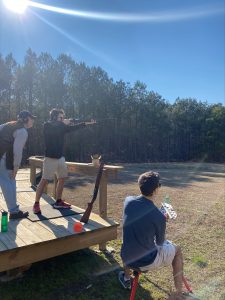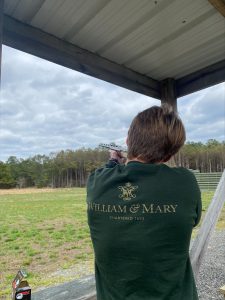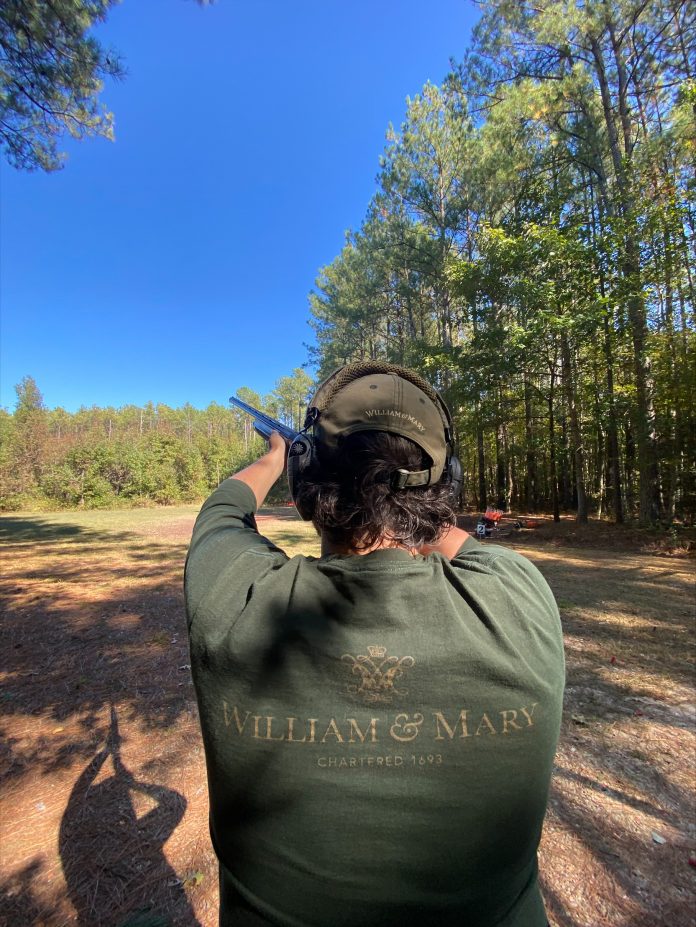Stunning sunsets, open forests and a ton of broken clay pigeons seem to be the defining traits for the College of William and Mary’s Clay Target Club. The Clay Target Club is an association dedicated to teaching and promoting the sport of clay pigeon shooting to nearly 100 participating students. Founded in 2018, the club, formerly known as the Rod and Gun club, began to make its rise as an inclusive club hoping to popularize recreational and safe skeet shooting, a sport in which participants fire shotguns at moving clay targets, on campus.
The origins of the sport can be traced back to late 18th century England, where players would shoot down live pigeons released in timed increments from sliding cages. Luckily for the feathered critters, the birds were replaced with clay disks in the 19th century — although the name remains symbolically. Nowadays, clay pigeon shooting requires participants to shoot down circular saucers that are launched out from ‘trap houses.’ With an assortment of clay disks, shotguns and challenges available to explore, including the unique “rabbit” shoots, where the disks are rolled instead of shot up, members of the Target club are certain to never grow tired of the sport.
The club hosts bi-monthly trips to local shooting ranges, allowing both experienced members and newcomers to test their clay target skills under the supervision of a licensed professional shooting coach.
“We meet with the instructor, whatever range we’re going to,” club member Quartz Drucker ’23 said. “And he helps the newer shooters sort of train, get their position, get their form right. And then, if the group is large enough to have two groups, the more experienced shooters will go and run their own courses.”
Once on the course, experienced members are brought through a series of different target setups and types of shooting. These exercises range from the classic skeet shooting to the newer and more complex ‘wobble trap’ — a version of skeet that involves rotating shooting locations, with five clay disks fired out from several stations. The variety of setups encourage players to shoot clay targets launched from different speeds and angles, using shotguns loaded with birdshot. The guns used by the club come from the members themselves or the club’s professional coach and all weapons are held and handled off-campus.

“We have a decent amount of people that have a very limited amount of experience,” Clay Target Club President Aubrey Bouchoux ’23 said.
“If you have good eyesight and are able to aim the shotgun, it’s really just about practice,” Joanie Sceppa ’23, another club member, said. “Obviously there are people who have been doing it for longer and have had a lot more practice and are a lot better at it. But there is not a single person there who is just born better at it.”
Members of Clay Target agree that the sport is very easy to progress in, even if you cannot make it to every practice since the sport is centered around accuracy, not strength. Breaks throughout the shoot are encouraged, and members will often move to easier targets to get their morale back up.
“Every time you miss, the coach tells you, ‘Okay, this is what you did wrong, here’s how we fix it for next time,” Sceppa said in regards to how constructive criticism helps members actively improve.
With around 15 to 20 students attending these individual shoots, the opportunity to learn from fellow members is especially significant.
“I’ve seen so much improvement, and I think even people who come out for the first time, they can see themselves improving just even in one session,” Sceppa said.
The club seems to prioritize creating safe spaces in a sport not traditionally perceived as open to people of all backgrounds.

“I think a lot of gun culture has a machismo problem, but I don’t really feel that Clay Target does,” Drucker said. “You have to make a process of making a space and ensuring that space is comfortable. And I think that’s being done. I don’t see a lot of toxic behavior in the club. And I think that’s really good because it provides a comfortable space for people who are just curious about the sport.”
In terms of plans for the future, the College’s Clay Target Club is hoping to expand its membership base and hopefully competition roster to rival the well-established teams of other regional universities, such as Virginia Tech.
“We haven’t had the opportunity to host any events because it turns out trying to host a shooting event-tournament-fundraiser type of thing is actually kind of hard,” Bouchoux said.
However, Bouchoux hopes to increase fundraising in order to pay for future equipment and tournament expenses. Currently, the range trips are priced at around fifteen dollars for each member, including the costs for equipment and range use.
“I think if you have curiosity about it, you should join,” Drucker said on why prospective members should take the leap. “And if you have anxiety about it, you should look into it because I think that it could be a good way to get more comfortable with the sport.”

